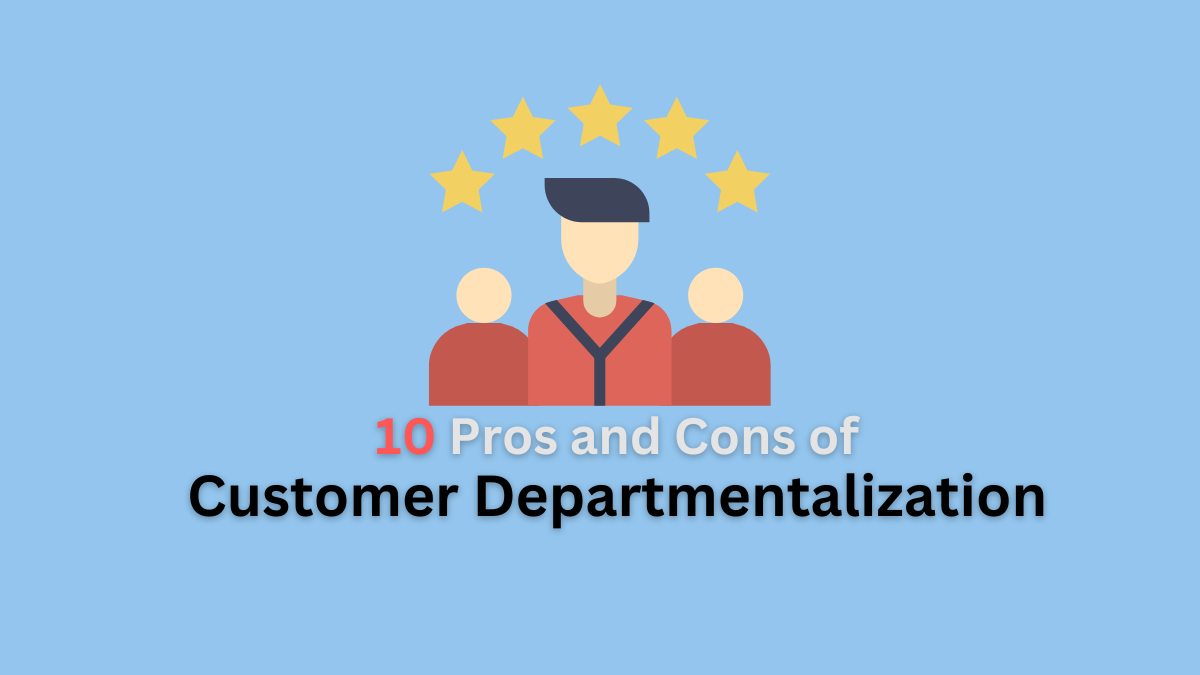Pros and Cons of Customer Departmentalization
Customer departmentalization is an organizational strategy where departments are structured based on specific customer groups or types. This approach aims to tailor services, activities, and resources to meet the unique needs, preferences, and requirements of distinct customer segments effectively.
In this article, we will explore 10 major pros and cons of customer departmentalization in the workplace, so let’s get started:
Pros of Customer Departmentalization
Here is an analysis of five key benefits of customer departmentalization in business:
Enhanced Customer Focus
Customer departmentalization allows organizations to prioritize understanding and catering to the unique needs of specific customer segments.
By structuring departments around different customer types (such as retail consumers, corporate clients, etc.), organizations can tailor their services more precisely. This enhances customer satisfaction and strengthens relationships by demonstrating a deep understanding of customer needs.
Tailored Service Offerings
Departments specializing in specific customer segments can offer tailored services that meet the precise requirements of those customers.
For example, retail-focused departments can design promotions and sales strategies that resonate with consumer preferences, leading to increased sales and customer loyalty.
Specialization and Expertise
Each department becomes proficient in handling the needs and demands of its assigned customer segment. This specialization allows employees to develop expertise in understanding customer behaviors, preferences, and expectations. As a result, organizations can deliver more effective and targeted solutions, enhancing overall service quality.
Improved Customer Relations
By focusing on specific customer groups, organizations can build stronger relationships with their customers.
Consistently meeting customer expectations fosters trust and loyalty, encouraging repeat business and positive word-of-mouth referrals. Stronger customer relations contribute to long-term business sustainability and growth.
Read More: 10 Major Pros and Cons of Committee Organization
Efficient Resource Allocation
Customer departmentalization enables organizations to allocate resources more efficiently based on customer demands.
Departments can prioritize their budgets, staffing, and operational strategies to align with the needs of their respective customer segments. This strategic allocation improves cost-effectiveness and enhances operational efficiency.
Cons of Customer Departmentalization
Now, let’s explore the five main drawbacks of customer departmentalization in the organization:
Operational Coordination Challenges
Coordinating activities and operations across different customer-focused departments can be complex. Each department may have its strategies, priorities, and timelines, leading to potential conflicts or inefficiencies in resource utilization.
Ensuring seamless coordination requires robust communication channels and collaboration efforts, which can be challenging to maintain.
Read More: 10 Major Pros and Cons of Matrix Organization
Need for Specialized Expertise
Managing departments tailored to specific customer segments demands specialized knowledge and skills. Organizations may need to invest in training and development programs to equip employees with the expertise required to effectively address diverse customer needs.
This requirement for specialized expertise can increase operational costs and resource allocation.
Blurry Customer Segment Definitions
Defining precise customer segments can be challenging, especially in markets where customer preferences and behaviors overlap.
This ambiguity can lead to confusion regarding which department is responsible for addressing certain customer requirements, potentially resulting in service gaps or redundancies.
Read More: 10 Pros and Cons of Functional Departmentalization
Potential for Inter-Departmental Conflict
Departments focused on different customer segments may compete for resources or prioritize conflicting objectives.
Inter-departmental conflicts can arise over budget allocations, staffing decisions, or strategic priorities, impacting overall organizational harmony and collaboration. Resolving such conflicts requires effective leadership and conflict-resolution strategies.
Risk of Over-Emphasis on Customer Segments
While customer departmentalization aims to enhance customer satisfaction, excessive focus on specific customer groups may divert attention from broader organizational goals. Departments may prioritize short-term customer needs at the expense of long-term strategic objectives, potentially limiting organizational growth and innovation.
In conclusion, customer departmentalization offers significant advantages by aligning organizational structures with customer-centric strategies. It enhances customer focus, tailors services, fosters specialization, improves customer relations, and optimizes resource allocation. However, it also presents challenges such as coordination difficulties, the need for specialized expertise, ambiguous customer segment definitions, potential conflicts, and the risk of losing sight of overarching organizational objectives.
Read Next: 10 Major Pros and Cons of Product Departmentalization
